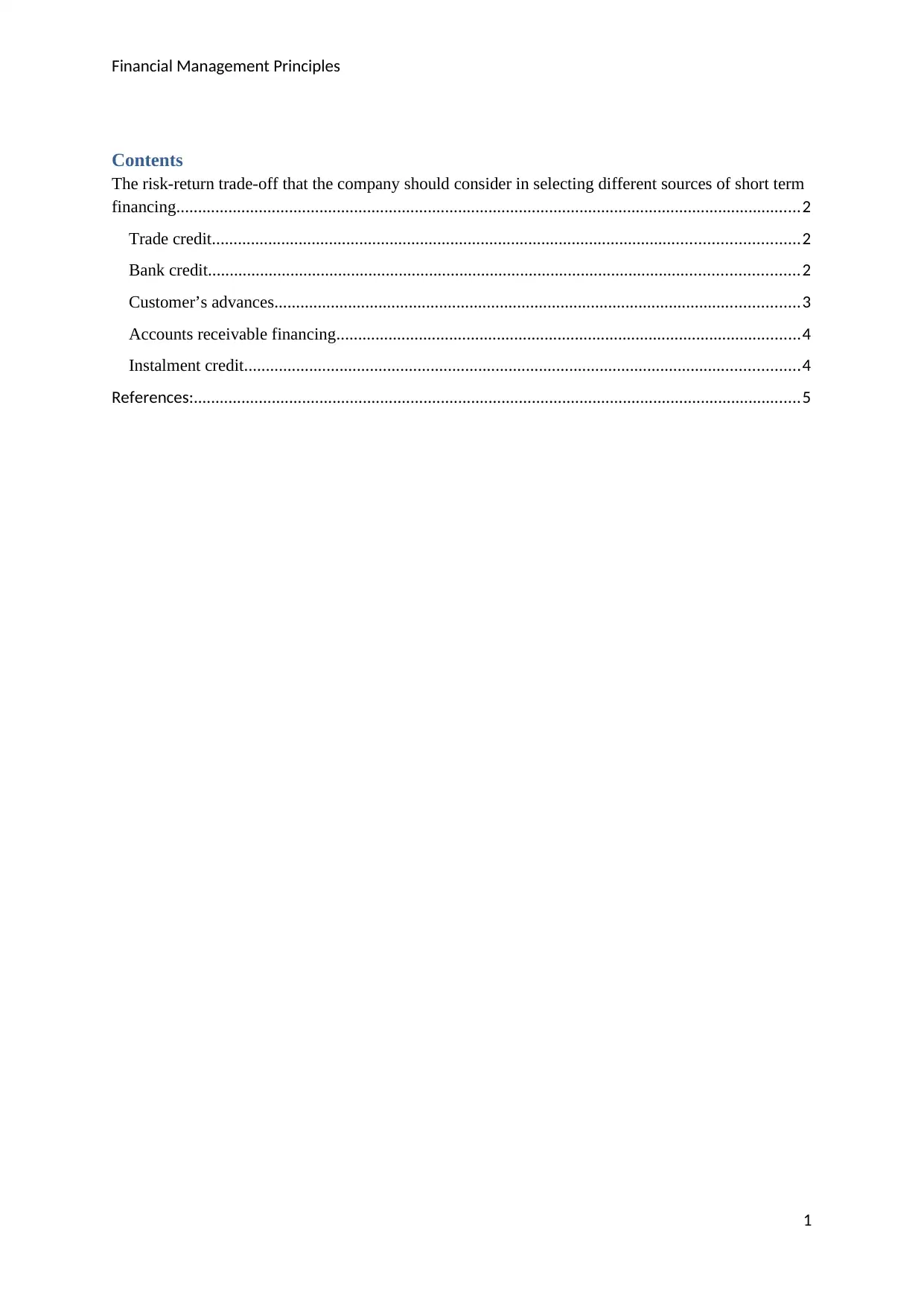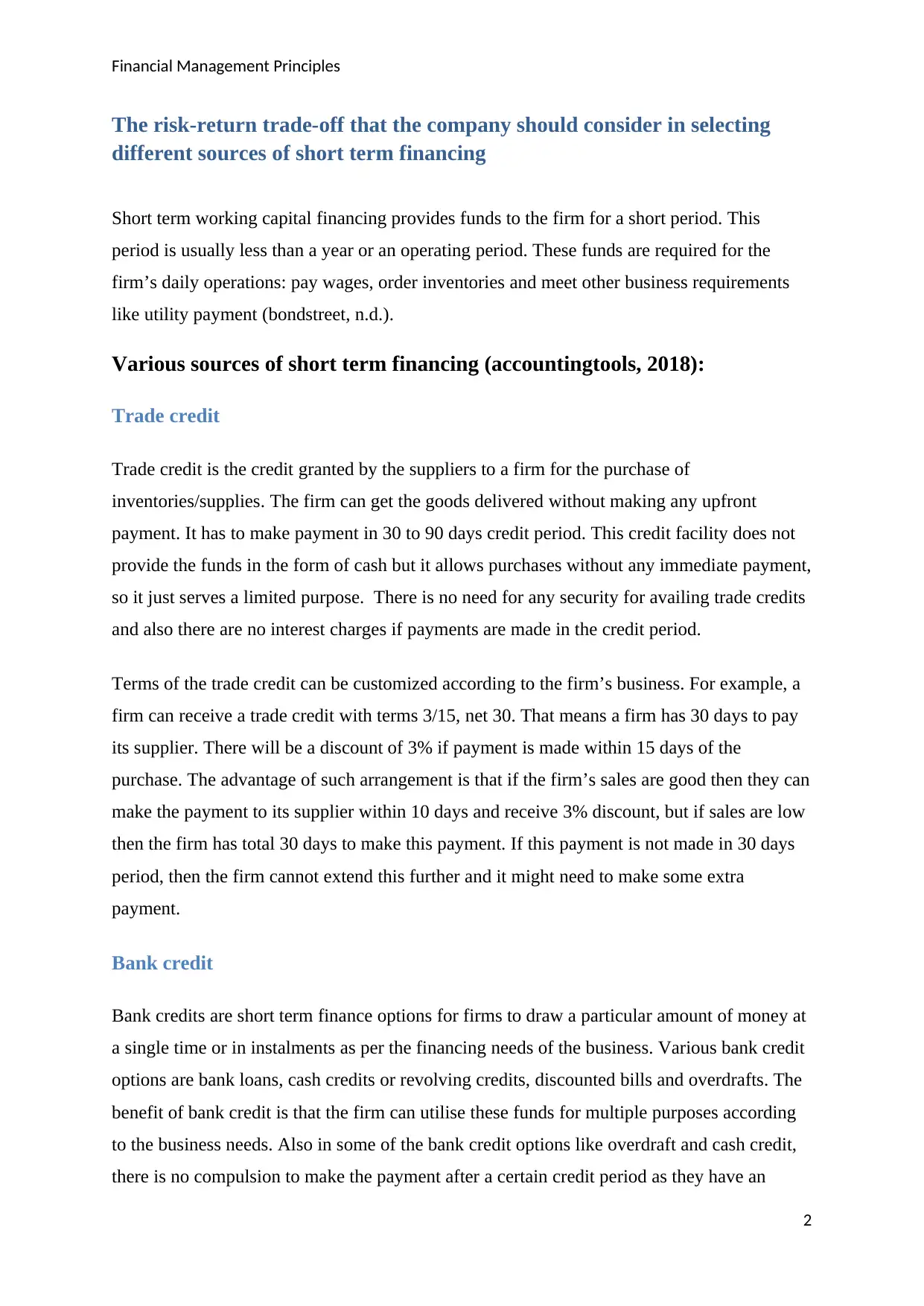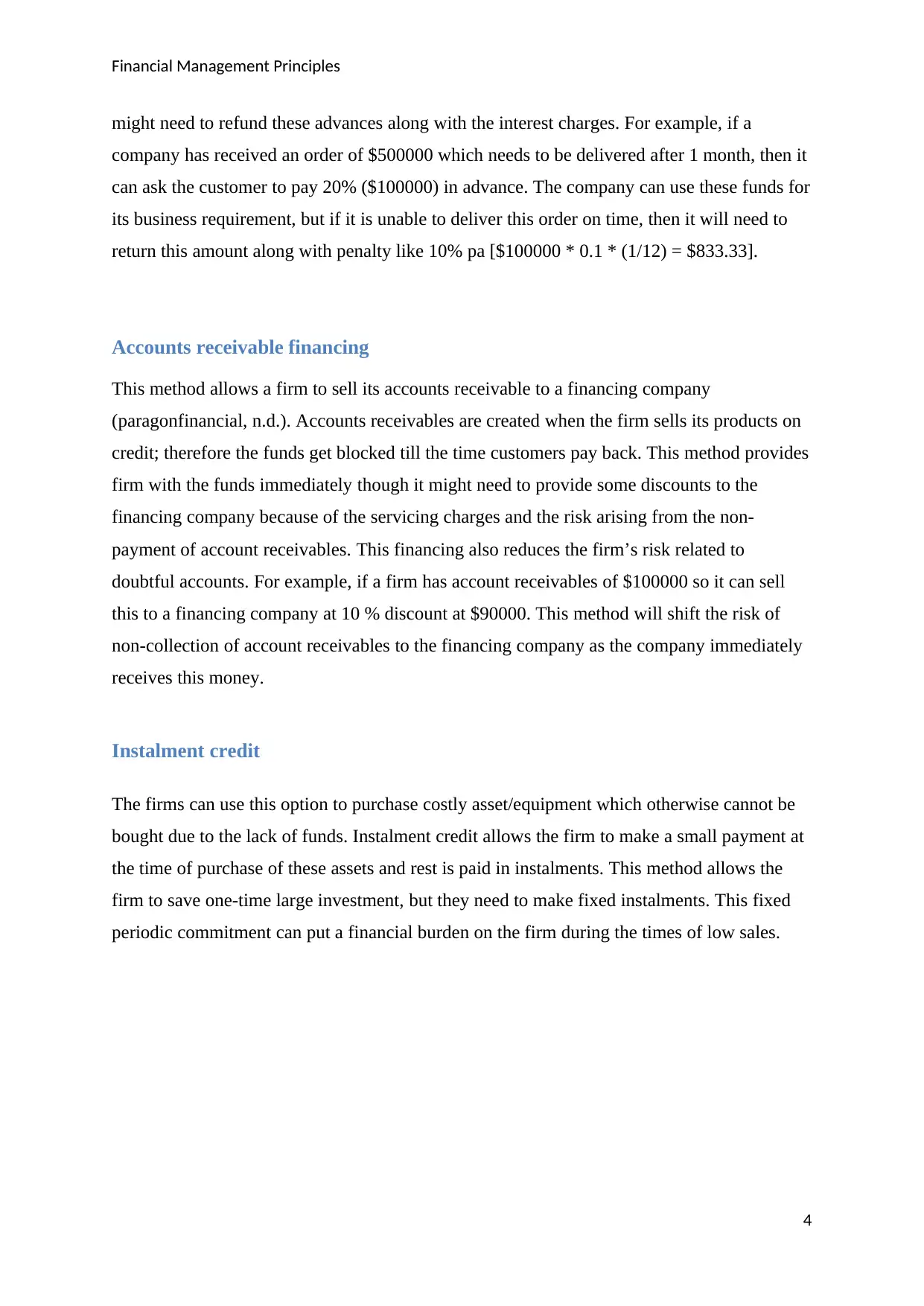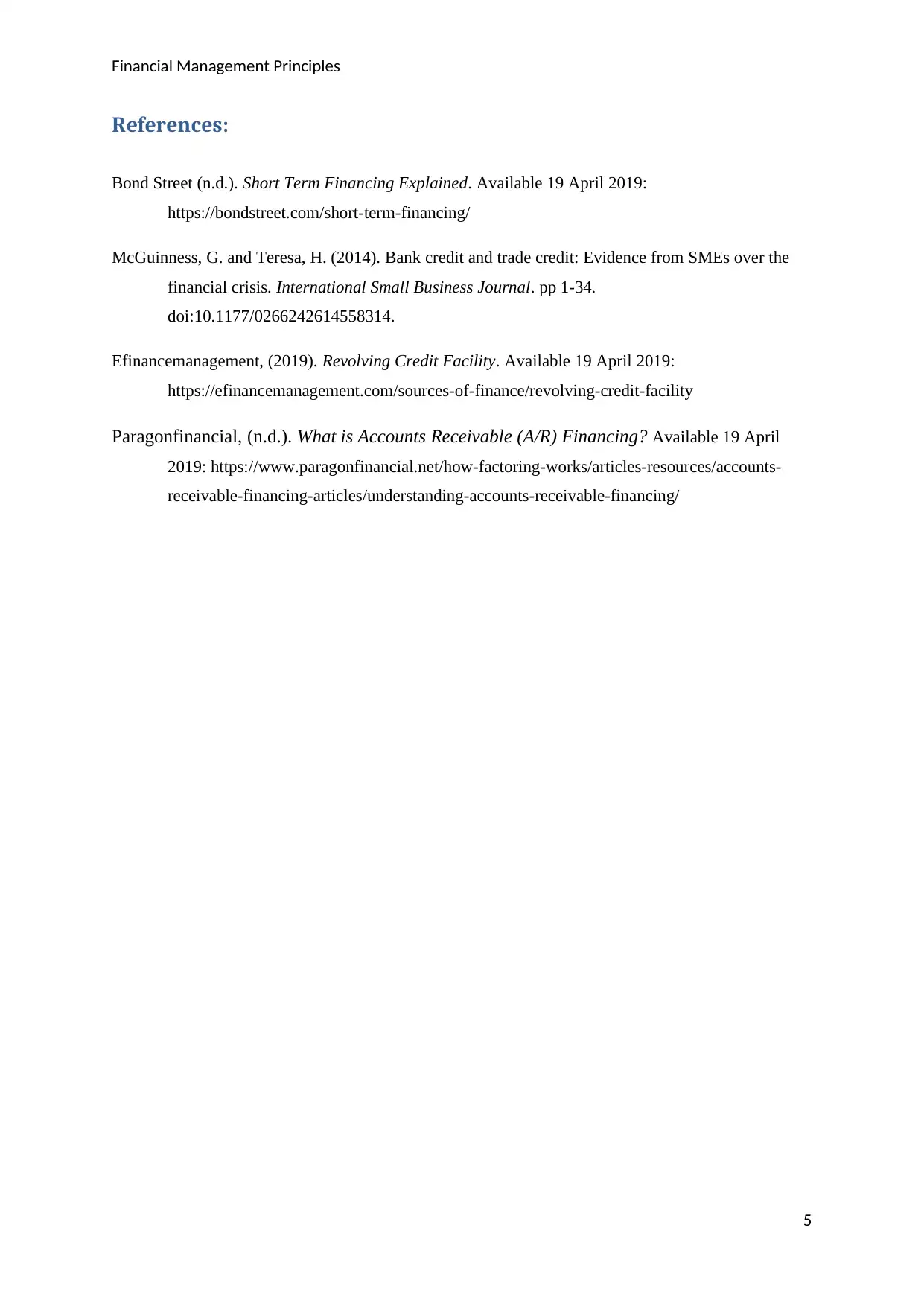University Finance Report: Short Term Financing Sources and Strategies
VerifiedAdded on 2023/01/19
|6
|1432
|81
Report
AI Summary
This report delves into the realm of short-term financing, providing a comprehensive overview of various funding sources available to businesses. It meticulously examines trade credit, elucidating its operational mechanics and associated advantages, such as the flexibility it offers in payment terms. The report proceeds to analyze bank credit, dissecting diverse options like bank loans, cash credits, and overdrafts, while also addressing the inherent risks and interest implications. Furthermore, it explores customer advances as a financing avenue, highlighting the upfront capital it provides, albeit with limitations and potential liabilities. Accounts receivable financing is also examined, detailing its role in immediate fund procurement, while the report concludes by discussing instalment credit, its utility in acquiring assets, and the ensuing financial commitments. The report emphasizes the risk-return trade-offs associated with each financing method, offering practical examples to illustrate key concepts, making it a valuable resource for students studying financial management.

Running Head: Financial Management Principles
Financial Management Principles
Student Name
University Name
Financial Management Principles
Student Name
University Name
Paraphrase This Document
Need a fresh take? Get an instant paraphrase of this document with our AI Paraphraser

Financial Management Principles
Contents
The risk-return trade-off that the company should consider in selecting different sources of short term
financing................................................................................................................................................2
Trade credit.......................................................................................................................................2
Bank credit........................................................................................................................................2
Customer’s advances.........................................................................................................................3
Accounts receivable financing...........................................................................................................4
Instalment credit................................................................................................................................4
References:............................................................................................................................................5
1
Contents
The risk-return trade-off that the company should consider in selecting different sources of short term
financing................................................................................................................................................2
Trade credit.......................................................................................................................................2
Bank credit........................................................................................................................................2
Customer’s advances.........................................................................................................................3
Accounts receivable financing...........................................................................................................4
Instalment credit................................................................................................................................4
References:............................................................................................................................................5
1

Financial Management Principles
The risk-return trade-off that the company should consider in selecting
different sources of short term financing
Short term working capital financing provides funds to the firm for a short period. This
period is usually less than a year or an operating period. These funds are required for the
firm’s daily operations: pay wages, order inventories and meet other business requirements
like utility payment (bondstreet, n.d.).
Various sources of short term financing (accountingtools, 2018):
Trade credit
Trade credit is the credit granted by the suppliers to a firm for the purchase of
inventories/supplies. The firm can get the goods delivered without making any upfront
payment. It has to make payment in 30 to 90 days credit period. This credit facility does not
provide the funds in the form of cash but it allows purchases without any immediate payment,
so it just serves a limited purpose. There is no need for any security for availing trade credits
and also there are no interest charges if payments are made in the credit period.
Terms of the trade credit can be customized according to the firm’s business. For example, a
firm can receive a trade credit with terms 3/15, net 30. That means a firm has 30 days to pay
its supplier. There will be a discount of 3% if payment is made within 15 days of the
purchase. The advantage of such arrangement is that if the firm’s sales are good then they can
make the payment to its supplier within 10 days and receive 3% discount, but if sales are low
then the firm has total 30 days to make this payment. If this payment is not made in 30 days
period, then the firm cannot extend this further and it might need to make some extra
payment.
Bank credit
Bank credits are short term finance options for firms to draw a particular amount of money at
a single time or in instalments as per the financing needs of the business. Various bank credit
options are bank loans, cash credits or revolving credits, discounted bills and overdrafts. The
benefit of bank credit is that the firm can utilise these funds for multiple purposes according
to the business needs. Also in some of the bank credit options like overdraft and cash credit,
there is no compulsion to make the payment after a certain credit period as they have an
2
The risk-return trade-off that the company should consider in selecting
different sources of short term financing
Short term working capital financing provides funds to the firm for a short period. This
period is usually less than a year or an operating period. These funds are required for the
firm’s daily operations: pay wages, order inventories and meet other business requirements
like utility payment (bondstreet, n.d.).
Various sources of short term financing (accountingtools, 2018):
Trade credit
Trade credit is the credit granted by the suppliers to a firm for the purchase of
inventories/supplies. The firm can get the goods delivered without making any upfront
payment. It has to make payment in 30 to 90 days credit period. This credit facility does not
provide the funds in the form of cash but it allows purchases without any immediate payment,
so it just serves a limited purpose. There is no need for any security for availing trade credits
and also there are no interest charges if payments are made in the credit period.
Terms of the trade credit can be customized according to the firm’s business. For example, a
firm can receive a trade credit with terms 3/15, net 30. That means a firm has 30 days to pay
its supplier. There will be a discount of 3% if payment is made within 15 days of the
purchase. The advantage of such arrangement is that if the firm’s sales are good then they can
make the payment to its supplier within 10 days and receive 3% discount, but if sales are low
then the firm has total 30 days to make this payment. If this payment is not made in 30 days
period, then the firm cannot extend this further and it might need to make some extra
payment.
Bank credit
Bank credits are short term finance options for firms to draw a particular amount of money at
a single time or in instalments as per the financing needs of the business. Various bank credit
options are bank loans, cash credits or revolving credits, discounted bills and overdrafts. The
benefit of bank credit is that the firm can utilise these funds for multiple purposes according
to the business needs. Also in some of the bank credit options like overdraft and cash credit,
there is no compulsion to make the payment after a certain credit period as they have an
2
⊘ This is a preview!⊘
Do you want full access?
Subscribe today to unlock all pages.

Trusted by 1+ million students worldwide

Financial Management Principles
option to continue this arrangement for another period. But certain risks associated with it are
that there is a need for some kind of security for the bank credit and in case of default the
firm will lose this security. Also, there are interest charges associated with the bank credit
depending upon the credit period, collateral arrangement and firm’s creditworthiness
(McGuinness and Hogan, 2014).
There are specific characteristics for different types of bank credit. For example:
Interest rate is lower in overdraft as compared to a cash credit facility.
Discounted bills provide immediate cash to the firm without waiting for a period specified on
the customer’s bills. But, the funds provided are discounted by the bank which means that the
firm needs to pay an advance interest payment.
Revolving credit has a benefit that it does not have a fixed repayment schedule which is a
requirement for term loans and overdraft. The revolving credit can be used to enhance firm’s
liquidity because in a situation where a firm does not have required funds it can use the
revolving credit facility to withdraw money. Another advantage of this facility is that there is
interest saving as the firm pays interest only for the amount of funds it borrowed and for the
period of borrowing (efinancemanagement, 2019). For example:
If a company has a revolving credit arrangement with a bank for $10,000 for 1 year with 5%
pa interest rate. If the company withdraws $5000 for 4 months period, then the interest
amount will be: $5000 * 0.05 * (4/12) = $83.33. But if this is a term loan for $10,000 for 1
year with 5% pa interest rate, then the interest amount will be: $10000 * 0.05 = $500. The
interest amount is higher in term loan as here the company needs to pay interest for the whole
sanctioned amount and the whole loan period.
Customer’s advances
In some cases when the order value is very large, the firms can require their customers to
make some payment in advance. These advance payments are a part of the product’s total
price but the firm get these funds upfront and there is no interest charges related to it. Also,
there is no need for the firm to deposit security for this credit option. The downside is that the
firm can get only a limited amount in advance which might not be sufficient to meet
immediate needs. Another risk is that if the firm is unable to deliver the goods on time, then it
3
option to continue this arrangement for another period. But certain risks associated with it are
that there is a need for some kind of security for the bank credit and in case of default the
firm will lose this security. Also, there are interest charges associated with the bank credit
depending upon the credit period, collateral arrangement and firm’s creditworthiness
(McGuinness and Hogan, 2014).
There are specific characteristics for different types of bank credit. For example:
Interest rate is lower in overdraft as compared to a cash credit facility.
Discounted bills provide immediate cash to the firm without waiting for a period specified on
the customer’s bills. But, the funds provided are discounted by the bank which means that the
firm needs to pay an advance interest payment.
Revolving credit has a benefit that it does not have a fixed repayment schedule which is a
requirement for term loans and overdraft. The revolving credit can be used to enhance firm’s
liquidity because in a situation where a firm does not have required funds it can use the
revolving credit facility to withdraw money. Another advantage of this facility is that there is
interest saving as the firm pays interest only for the amount of funds it borrowed and for the
period of borrowing (efinancemanagement, 2019). For example:
If a company has a revolving credit arrangement with a bank for $10,000 for 1 year with 5%
pa interest rate. If the company withdraws $5000 for 4 months period, then the interest
amount will be: $5000 * 0.05 * (4/12) = $83.33. But if this is a term loan for $10,000 for 1
year with 5% pa interest rate, then the interest amount will be: $10000 * 0.05 = $500. The
interest amount is higher in term loan as here the company needs to pay interest for the whole
sanctioned amount and the whole loan period.
Customer’s advances
In some cases when the order value is very large, the firms can require their customers to
make some payment in advance. These advance payments are a part of the product’s total
price but the firm get these funds upfront and there is no interest charges related to it. Also,
there is no need for the firm to deposit security for this credit option. The downside is that the
firm can get only a limited amount in advance which might not be sufficient to meet
immediate needs. Another risk is that if the firm is unable to deliver the goods on time, then it
3
Paraphrase This Document
Need a fresh take? Get an instant paraphrase of this document with our AI Paraphraser

Financial Management Principles
might need to refund these advances along with the interest charges. For example, if a
company has received an order of $500000 which needs to be delivered after 1 month, then it
can ask the customer to pay 20% ($100000) in advance. The company can use these funds for
its business requirement, but if it is unable to deliver this order on time, then it will need to
return this amount along with penalty like 10% pa [$100000 * 0.1 * (1/12) = $833.33].
Accounts receivable financing
This method allows a firm to sell its accounts receivable to a financing company
(paragonfinancial, n.d.). Accounts receivables are created when the firm sells its products on
credit; therefore the funds get blocked till the time customers pay back. This method provides
firm with the funds immediately though it might need to provide some discounts to the
financing company because of the servicing charges and the risk arising from the non-
payment of account receivables. This financing also reduces the firm’s risk related to
doubtful accounts. For example, if a firm has account receivables of $100000 so it can sell
this to a financing company at 10 % discount at $90000. This method will shift the risk of
non-collection of account receivables to the financing company as the company immediately
receives this money.
Instalment credit
The firms can use this option to purchase costly asset/equipment which otherwise cannot be
bought due to the lack of funds. Instalment credit allows the firm to make a small payment at
the time of purchase of these assets and rest is paid in instalments. This method allows the
firm to save one-time large investment, but they need to make fixed instalments. This fixed
periodic commitment can put a financial burden on the firm during the times of low sales.
4
might need to refund these advances along with the interest charges. For example, if a
company has received an order of $500000 which needs to be delivered after 1 month, then it
can ask the customer to pay 20% ($100000) in advance. The company can use these funds for
its business requirement, but if it is unable to deliver this order on time, then it will need to
return this amount along with penalty like 10% pa [$100000 * 0.1 * (1/12) = $833.33].
Accounts receivable financing
This method allows a firm to sell its accounts receivable to a financing company
(paragonfinancial, n.d.). Accounts receivables are created when the firm sells its products on
credit; therefore the funds get blocked till the time customers pay back. This method provides
firm with the funds immediately though it might need to provide some discounts to the
financing company because of the servicing charges and the risk arising from the non-
payment of account receivables. This financing also reduces the firm’s risk related to
doubtful accounts. For example, if a firm has account receivables of $100000 so it can sell
this to a financing company at 10 % discount at $90000. This method will shift the risk of
non-collection of account receivables to the financing company as the company immediately
receives this money.
Instalment credit
The firms can use this option to purchase costly asset/equipment which otherwise cannot be
bought due to the lack of funds. Instalment credit allows the firm to make a small payment at
the time of purchase of these assets and rest is paid in instalments. This method allows the
firm to save one-time large investment, but they need to make fixed instalments. This fixed
periodic commitment can put a financial burden on the firm during the times of low sales.
4

Financial Management Principles
References:
Bond Street (n.d.). Short Term Financing Explained. Available 19 April 2019:
https://bondstreet.com/short-term-financing/
McGuinness, G. and Teresa, H. (2014). Bank credit and trade credit: Evidence from SMEs over the
financial crisis. International Small Business Journal. pp 1-34.
doi:10.1177/0266242614558314.
Efinancemanagement, (2019). Revolving Credit Facility. Available 19 April 2019:
https://efinancemanagement.com/sources-of-finance/revolving-credit-facility
Paragonfinancial, (n.d.). What is Accounts Receivable (A/R) Financing? Available 19 April
2019: https://www.paragonfinancial.net/how-factoring-works/articles-resources/accounts-
receivable-financing-articles/understanding-accounts-receivable-financing/
5
References:
Bond Street (n.d.). Short Term Financing Explained. Available 19 April 2019:
https://bondstreet.com/short-term-financing/
McGuinness, G. and Teresa, H. (2014). Bank credit and trade credit: Evidence from SMEs over the
financial crisis. International Small Business Journal. pp 1-34.
doi:10.1177/0266242614558314.
Efinancemanagement, (2019). Revolving Credit Facility. Available 19 April 2019:
https://efinancemanagement.com/sources-of-finance/revolving-credit-facility
Paragonfinancial, (n.d.). What is Accounts Receivable (A/R) Financing? Available 19 April
2019: https://www.paragonfinancial.net/how-factoring-works/articles-resources/accounts-
receivable-financing-articles/understanding-accounts-receivable-financing/
5
⊘ This is a preview!⊘
Do you want full access?
Subscribe today to unlock all pages.

Trusted by 1+ million students worldwide
1 out of 6
Related Documents
Your All-in-One AI-Powered Toolkit for Academic Success.
+13062052269
info@desklib.com
Available 24*7 on WhatsApp / Email
![[object Object]](/_next/static/media/star-bottom.7253800d.svg)
Unlock your academic potential
Copyright © 2020–2025 A2Z Services. All Rights Reserved. Developed and managed by ZUCOL.




